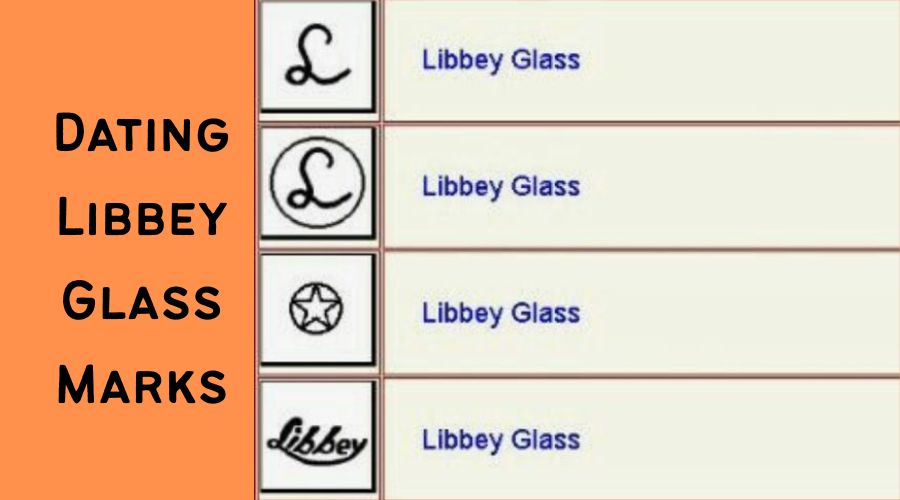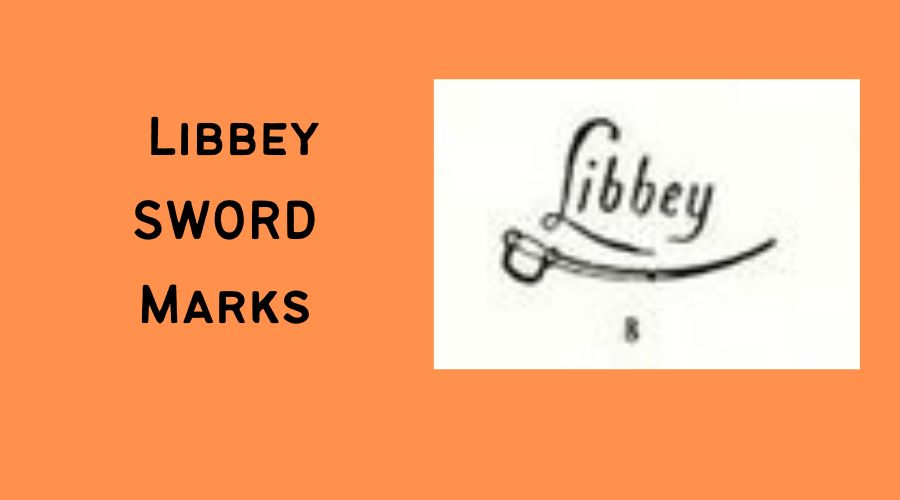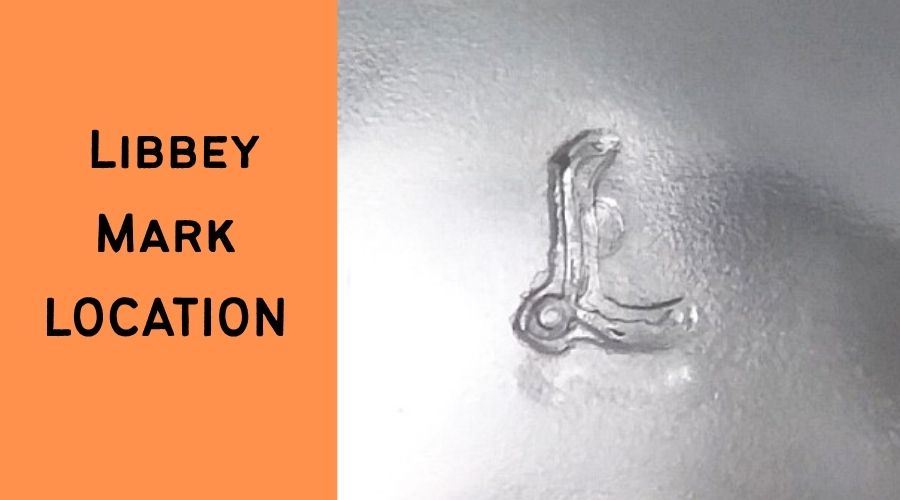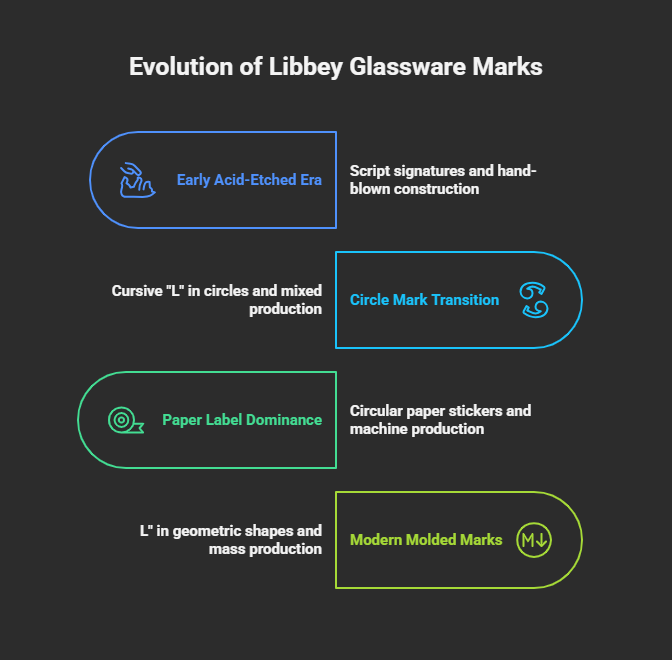You’ve just found a stunning piece of glassware at an estate sale. The delicate curves catch the light perfectly.
There’s something elegant about it that screams quality. But here’s the million-dollar question: is it actually valuable vintage Libbey?
Dating Libbey glass marks becomes your secret weapon for unlocking the mystery behind that beautiful find.
You’re holding a piece that could be worth hundreds or just twenty dollars. The difference lies in a tiny mark, often no bigger than your thumbnail.
It’s like being a detective, but instead of solving crimes, you’re solving the puzzle of glass history. And trust me, once you crack the code, you’ll never look at glassware the same way again.
The Toledo Legacy: Where It All Began
Understanding Libbey glass marks starts with knowing the story. In 1888, Edward Drummond Libbey moved his glass company from Cambridge, Massachusetts, to Toledo, Ohio.
Why Toledo? Simple. The city offered abundant natural resources for glassmaking, plus it gave Libbey four acres and 50 lots for worker housing.
This wasn’t just a business move. It was the birth of America’s glass capital.

The company traces its roots back to 1818 with the New England Glass Company.
But the real magic happened when Edward Libbey took control. He transformed a struggling Eastern company into a glass empire.
Key Historical Dates:
- 1818: New England Glass Company founded
- 1883: Edward Drummond Libbey takes control
- 1888: Company moves to Toledo
- 1892: Officially becomes Libbey Glass Company
Think of it this way: every mark on your Libbey piece tells part of this incredible story. Each signature represents a different chapter in American glassmaking history.
The Mark Evolution: Your Dating Roadmap

Here’s where things get exciting. Libbey marks changed over time, giving you a roadmap to date your pieces. It’s like reading the DNA of your glassware.
Early Period Marks (1890s-1920s)
The earliest Libbey pieces often featured the company name in script. The trademark application stated it consisted of the word “Libbey” and a representation of a sword under the word.

These early marks are rare treasures.
What to Look For:
- Full “Libbey” script writing
- Sword underneath the name
- Usually acid-etched, not molded
- Often quite small and delicate
This sword trademark has been found on glass dated as early as 1902, though it’s seldom seen. Finding one is like discovering a piece of American industrial history.
The Circle Era (1920s-1940s)
The 1920s brought a major change. Around 1924, Libbey introduced the cursive L inside a “double circle” or “double-ring”. This became their signature look for decades.
Cursive L on the bottom of the Glass
Meaning
The cursive L mark on the bottom of the glass indicates it was manufactured by the Libbey Glass Company, one of America’s most prolific and historic glassware manufacturers.
The company originated as the New England Glass Company in East Cambridge, Massachusetts, in 1818.
Edward Drummond Libbey moved the operation to Toledo, Ohio, approximately 70 years later, and renamed it the Libbey Glass Company.
Evolution of the Mark
The cursive L trademark evolved through distinct periods that help date pieces:
1920-1936: A cursive “L” inside a double circle (created around 1924)
1937-1954: A three-segmented circle with the cursive “L” inside (created around 1937)
1955-1980s: A single circle containing the cursive capital “L” (introduced in 1955). This mark often appears backwards when viewed from outside the glass, but reads correctly when looking down through the inside.
Recent decades: Just the cursive “L” alone without any circle, rendered with delicate styling.
The mark can appear clear on some pieces, while on others it’s lightly embossed, faint, smeared, or nearly invisible—sometimes resembling a short curly hair embedded in the glass surface.
Notable History
In 1933, Libbey hired Douglas Nash, a former Tiffany designer, to create luxury stemware with eighty-two cut and engraved patterns inspired by Art Nouveau.
The company produced highly collectible Disney Snow White promotional glassware in 1937.
In the 1960s, Libbey introduced dimensional designs with bold colors (bronze, gold, pink) and nature motifs. Popular patterns include Gibraltar, Golden Ice, Danube, and Roses.
Value and Worth
Libbey glassware value ranges dramatically from very affordable to expensive. Common mid-century tumblers typically sell for $5-15 each.
Corelle Coordinates glasses from the 1970s-1980s fetch $10-15 each. Vintage Nash-designed luxury pieces and Disney promotional items command higher prices.
Value depends on age, pattern rarity, condition, completeness of sets, and historical significance. While common pieces are affordable, they represent authentic American glass-making heritage.
The Paper Label Revolution (1930s-1960s)
Here’s where many collectors get confused. The mid-century period marked a dramatic shift to paper labels. These circular or oval paper stickers became Libbey’s primary marking method.
Paper Label Characteristics:
- Circular labels with “Libbey” inside a circle
- Two main versions: thick black circle (1920-1930s) and empty double circle (1939-1945)
- Often included pattern names or numbers
- Many labels are lost over time, making identification challenging
This period creates both opportunities and frustrations for collectors. Finding pieces with intact paper labels is like discovering buried treasure—rare and valuable.
The Final Script Era (1950s)
The last major etched signature was the 1958 stemware patterns known as the “1818” line, featuring the Libbey name in script with a sword above and below.
This creates an interesting collecting opportunity. These 1950s pieces bridge vintage charm with more accessible pricing.
Modern Era Marks (1970s-Present)
The 1970s brought the modern era of Libbey marking. Simple, clean, and unmistakable.
Molded Marks in Glass:
- “L” inside a circle or square
- “Libbey” spelled out in raised letters
- Sometimes includes “USA” designation
- Pattern numbers or codes may be present
These molded marks represent a complete departure from earlier methods. They’re permanent, clear, and easy to identify, perfect for mass production needs.
You can’t date what you can’t find. Libbey marks have favorite hiding spots, and knowing where to look saves time and frustration.
Primary Mark Locations

Bottom Center: Most common location for etched marks. Turn your piece over and look for small script or symbols in the center of the base.
Near the Rim: Some pieces feature marks just below the rim, especially on stemware and tumblers.
Handle Area: Pitchers and handled pieces sometimes carry marks near the handle attachment.
Stem Base: Wine glasses and goblets often have marks where the bowl meets the stem.
Key Dating Timeline Summary

Here’s your quick reference guide for Libbey glass dating:
1888-1920s: Early Acid-Etched Era
- Script “Libbey” signatures
- Hand-blown construction
- Highest collector values
1920s-1930s: Circle Mark Transition
- Cursive “L” in double circles
- Beginning of machine production
- Mixed hand-blown and machine pieces
1930s-1960s: Paper Label Dominance
- Circular paper stickers
- “Libbey” inside circle designs
- Machine-made construction standard
1970s-Present: Modern Molded Marks
- “L” in geometric shapes
- Molded directly into glass
- Mass production focus
Acid-Etched Marks:
- Feel slightly rough to the touch
- Usually clear or frosted appearance
- Most authentic and valuable
- Used from 1890s through 1950s
Molded Marks:
- Raised or recessed into the glass
- Smooth to the touch
- More common on mass-produced pieces
- Generally less valuable than etched
Paper Labels:
- Black stickers with white lettering
- Found on 1950s pieces and later
- Often lost over time
- Less reliable for dating.
The Value Connection: Why Dating Matters
Here’s the truth: collectors don’t always share. Not all Libbey glass is created equal. Dating your marks directly impacts value, and understanding this relationship puts money in your pocket.
High-Value Periods
Brilliant Cut Period (1890s-1915): This era produced Libbey’s most valuable pieces. Libbey became the largest cut glass factory in the world during the Brilliant Period. Pieces from this era with proper marks can sell for hundreds or thousands.
Art Glass Era (1900s-1920s): Experimental pieces and artistic collaborations. Look for unusual colors or techniques combined with early marks.
Depression Era Transition (1920s-1930s): The circle marks from this period represent good value. Quality remained high while prices stayed accessible.
Moderate Value Periods
Mid-Century Modern (1940s-1960s): Clean lines and simple marks. Growing collector interest, but still affordable.
Contemporary Pieces (1970s-Present): Generally lower collectible value but perfect for daily use. Plus, there’s always the question of understanding if Libbey glass has lead, which becomes crucial for modern safety-conscious collectors.
Market Insights
The antique glass market follows specific patterns:
- Rarity drives premium pricing
- Condition matters more than age sometimes
- Complete sets command higher prices
- Unusual colors or patterns increase value.
Authenticity Alert: Spotting Fakes and Reproductions
The popularity of vintage Libbey has created a thriving reproduction market. Knowing how to spot fakes protects your investment and reputation.
Red Flags for Reproductions
Mark Quality:
- Poorly executed script
- Wrong fonts or styles
- Marks that look “too perfect”
- Inconsistent sizing
Glass Quality:
- Lighter weight than expected
- Poor optical clarity
- Visible mold lines
- Rough pontil marks
Historical Inconsistencies:
- Marks that don’t match known periods
- Modern glass with vintage-style marks
- Patterns that never existed historically
Authentication Tips
Research First: Use reputable reference books and databases. Cross-reference mark styles with known production periods.
Feel the Difference: Authentic vintage Libbey has weight and quality that’s hard to fake. The glass feels substantial and well-made.
Compare Similar Pieces: Study authentic examples at museums or reputable dealers. Your eyes will develop over time.
Seek Expert Opinion: When in doubt, consult experienced collectors or professional appraisers.
Tools of the Trade: Essential Dating Resources
Professional collectors don’t work from memory alone. They use specific tools and resources to verify their findings.
Reference Books
“Bottle Makers and Their Marks” by Julian Toulouse (1971): Illustrates the cursive L marks with introduction dates. Essential for serious collectors.
“400 Trademarks on Glass” by Arthur G. Peterson (1968): Mentions the 1937 three-segmented circle mark. Great for cross-referencing.
Company Catalogs: Original Libbey catalogs provide definitive proof of patterns and dating.
Online Resources
Glass Encyclopedia Websites: Comprehensive databases with photos and dates.
Collector Forums: Connect with experienced collectors who share knowledge freely.
Auction Archives: Research completed sales to understand current market values.
Physical Tools
Magnifying Glass: Essential for reading small or worn marks clearly.
UV Light: Some marks show better under ultraviolet light.
Digital Calipers: Precise measurements help identify specific patterns.
Camera with Macro Lens: Document your pieces for future reference.
Condition Assessment: How Wear Affects Dating
Even perfect mark identification means nothing if you can’t assess the condition properly. Wear patterns tell stories about age and authenticity.
Age-Related Wear Patterns
Natural Aging Signs:
- Slight cloudiness from washing
- Minor scratches from use
- Wear on high-contact areas
- Patina development on older pieces
Concerning Damage:
- Chips or cracks
- Deep scratches
- Acid damage from improper cleaning
- Heat damage from dishwashers
Dating Through Wear
Interestingly, wear patterns help confirm age. A piece claiming to be from 1920 should show appropriate aging. Brand-new looking “vintage” pieces raise red flags.
Authentic Wear Indicators:
- Consistent aging throughout
- Wear patterns match expected use
- Proper patina development
- Natural-looking surface changes
Regional Variations: Toledo vs. Other Locations
While Toledo remained Libbey’s primary location, the company operated other facilities over the years. These regional differences affect both dating and value.
Toledo Production Characteristics
Quality Standards: Toledo pieces generally represent the highest quality Libbey production.
Mark Consistency: More consistent marking practices due to centralized quality control.
Pattern Availability: Widest range of patterns and styles produced.
Subsidiary Operations
Different Marking Practices: Some subsidiary operations used different marking systems or no marks at all.
Quality Variations: Secondary facilities sometimes produced lower-grade pieces for the mass market.
Dating Challenges: Pieces from subsidiary operations can be harder to date accurately.
Building Your Collection: Smart Acquisition Strategies
Understanding mark dating transforms you from a casual browser to a strategic collector. Here’s how to build a collection that grows in value over time.
Focus Areas for New Collectors
Single Pattern Mastery: Choose one pattern and learn everything about it. This focused approach builds expertise quickly.
Mark Period Specialization: Concentrate on one mark era. Become the expert on circle marks or script signatures.
Condition-Based Collecting: Focus on excellent condition pieces, even if they’re more common patterns.
Advanced Collecting Strategies
Gap Filling: Identify missing pieces in established collections and target those specifically.
Market Timing: Buy during market downturns and sell during peaks.
Cross-Pattern Collecting: Look for pieces that bridge different collecting categories.
Investment Potential: The Long View
Smart collectors think beyond immediate pleasure. They consider long-term investment potential when evaluating Libbey pieces.
Growing Market Segments
Mid-Century Modern: Increasing interest from younger collectors drives prices up.
Complete Sets: Intact sets command premium pricing and show strong appreciation.
Rare Colors: Unusual color variations continue to attract collector interest.
Market Trends to Watch
Demographic Shifts: As baby boomers downsize, more vintage pieces enter the market.
Authentication Technology: Better authentication methods may affect future valuations.
International Interest: Growing global collecting interest expands market potential.
Conservation and Care: Protecting Your Investment
Proper care preserves both the physical condition and historical integrity of your Libbey collection.
Cleaning Best Practices
Gentle Methods Only: Use mild dish soap and soft cloths. Avoid abrasive cleaners or scrubbers.
Temperature Considerations: Sudden temperature changes can crack vintage glass. Room temperature water works best.
Drying Techniques: Air dry when possible. If towel drying, use lint-free cloths.
Storage Solutions
Individual Protection: Wrap each piece in acid-free tissue paper.
Climate Control: Stable temperature and humidity prevent stress fractures.
Display Considerations: Keep pieces away from direct sunlight and high-traffic areas.
Your Next Steps: From Knowledge to Action
Now you have the tools to confidently date Libbey glass marks. But knowledge without action remains just interesting information.
Start Small: Begin with pieces you already own. Practice identifying marks and dating them.
Join Communities: Connect with other collectors through forums and local clubs.
Keep Learning: Glass history is deep and fascinating. There’s always more to discover.
Document Everything: Create detailed records of your pieces, including photos and research notes.
The world of Libbey glass collecting offers endless fascination. Every mark tells a story.
Every piece connects you to American industrial history. And every successful identification brings the satisfaction of solving a beautiful puzzle.